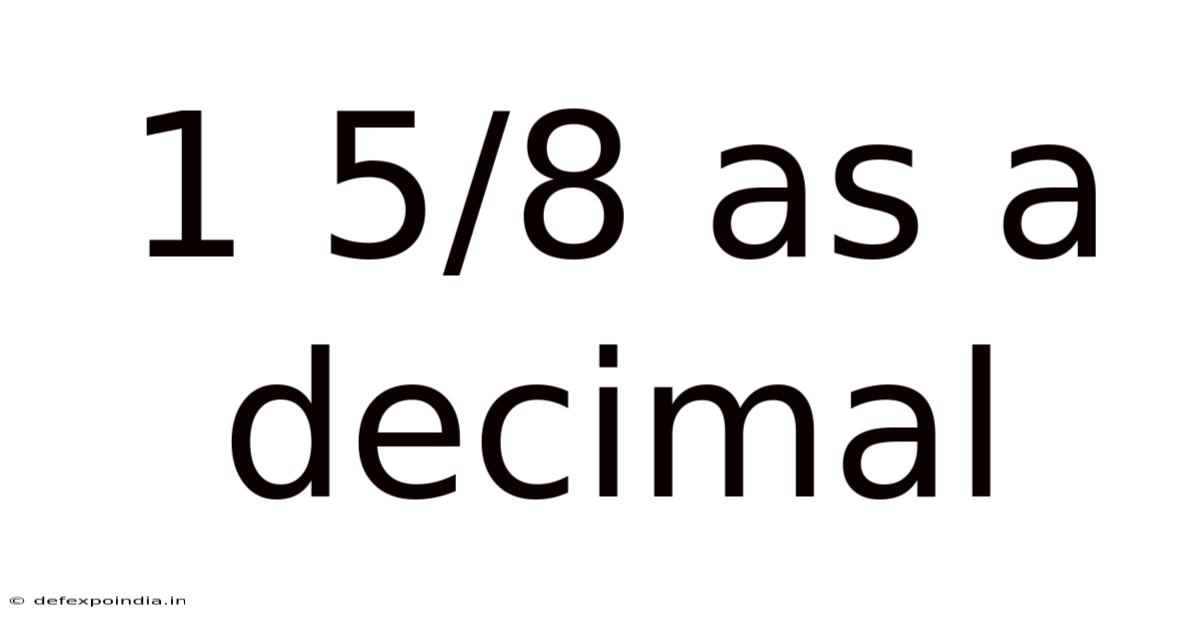1 5/8 As A Decimal
defexpoindia
Sep 25, 2025 · 4 min read

Table of Contents
1 5/8 as a Decimal: A Comprehensive Guide
Understanding fractions and their decimal equivalents is fundamental to mathematics and numerous real-world applications. This article provides a comprehensive explanation of how to convert the mixed number 1 5/8 into its decimal form, exploring various methods and delving into the underlying mathematical principles. We'll cover multiple approaches, addressing common questions and misconceptions along the way, ensuring a clear and complete understanding for learners of all levels. This guide will equip you with the skills to confidently tackle similar conversions and strengthen your foundational mathematical knowledge.
Introduction: Understanding Mixed Numbers and Decimals
Before diving into the conversion process, let's clarify some key terms. A mixed number combines a whole number and a fraction, like 1 5/8. A decimal represents a number using a base-ten system, where digits to the right of the decimal point represent fractions of powers of ten (tenths, hundredths, thousandths, etc.). Converting a mixed number to a decimal involves expressing the fractional part as a decimal and then adding it to the whole number.
Method 1: Converting the Fraction to a Decimal Directly
This is perhaps the most straightforward approach. We start by converting the fraction 5/8 into a decimal. To do this, we divide the numerator (5) by the denominator (8):
5 ÷ 8 = 0.625
Now, we add this decimal value to the whole number part of the mixed number:
1 + 0.625 = 1.625
Therefore, 1 5/8 as a decimal is 1.625.
Method 2: Converting to an Improper Fraction First
Another method involves first converting the mixed number into an improper fraction. An improper fraction has a numerator larger than or equal to its denominator. To convert 1 5/8 to an improper fraction:
- Multiply the whole number (1) by the denominator (8): 1 * 8 = 8
- Add the numerator (5) to the result: 8 + 5 = 13
- Keep the same denominator (8): The improper fraction is 13/8
Now, we divide the numerator (13) by the denominator (8):
13 ÷ 8 = 1.625
This confirms that 1 5/8 is equal to 1.625 in decimal form.
Method 3: Using Decimal Equivalents of Common Fractions
For frequently used fractions, it's helpful to memorize their decimal equivalents. Knowing that 1/8 = 0.125 can significantly speed up the process. Since 5/8 is five times 1/8, we can calculate:
5 * 0.125 = 0.625
Adding the whole number:
1 + 0.625 = 1.625
This method leverages pre-existing knowledge to simplify the calculation, demonstrating the efficiency of memorizing common fraction-decimal conversions.
Understanding the Decimal Place Value
The decimal 1.625 can be broken down into its place values:
- 1: Represents the whole number.
- 6: Represents six tenths (6/10).
- 2: Represents two hundredths (2/100).
- 5: Represents five thousandths (5/1000).
This breakdown reinforces the understanding of how the decimal system represents fractional parts.
Applications of Decimal Conversions
The ability to convert fractions to decimals is crucial in various fields:
- Engineering and Construction: Precise measurements often require decimal representations for calculations involving dimensions and materials.
- Finance: Calculating interest rates, percentages, and monetary values frequently necessitates converting fractions to decimals.
- Science: Scientific measurements and data analysis often involve decimals for accuracy and consistency.
- Computer Programming: Many programming languages rely on decimal representations for numerical computations and data storage.
Frequently Asked Questions (FAQ)
Q1: Can I use a calculator to convert 1 5/8 to a decimal?
A1: Yes, absolutely! Most calculators have a fraction-to-decimal function. Simply enter 1 5/8 (or its equivalent improper fraction 13/8) and press the equals sign. The calculator will directly provide the decimal equivalent, 1.625.
Q2: What if the fraction doesn't divide evenly?
A2: If the fraction results in a non-terminating decimal (a decimal that goes on forever without repeating), you may need to round the decimal to a certain number of decimal places depending on the required precision of your application. For example, 1/3 = 0.3333... You might round this to 0.33 or 0.333 depending on the level of accuracy needed.
Q3: Are there other ways to represent 1 5/8?
A3: Yes! Besides the decimal representation 1.625, you could also express 1 5/8 as a percentage (162.5%). Percentages are another way of representing fractions and decimals.
Q4: Why is it important to understand these conversion methods?
A4: Understanding how to convert between fractions and decimals is essential for building a strong foundation in mathematics. It allows you to work fluently with different number representations, solving problems more efficiently and accurately in diverse contexts.
Conclusion: Mastering Fraction-to-Decimal Conversions
Converting 1 5/8 to its decimal equivalent, 1.625, involves a straightforward process. Whether you choose to convert the fraction directly, use the improper fraction method, or leverage known decimal equivalents, the result remains consistent. Mastering this skill is crucial for various mathematical applications, and understanding the underlying principles will allow you to confidently tackle more complex fraction-to-decimal conversions in the future. Remember to practice regularly, and soon you will find these conversions become second nature. This comprehensive guide aimed to equip you not only with the solution but also with a deeper understanding of the concepts involved. By understanding the why behind the how, you build a more robust and flexible mathematical skillset.
Latest Posts
Latest Posts
-
325 Grados Farenheit A Centigrados
Sep 25, 2025
-
How Many Btus Per Watt
Sep 25, 2025
-
Convert Hp To Kva Calculator
Sep 25, 2025
-
How Many Feet Is 56
Sep 25, 2025
-
Cuantos Cm Son 7 Pies
Sep 25, 2025
Related Post
Thank you for visiting our website which covers about 1 5/8 As A Decimal . We hope the information provided has been useful to you. Feel free to contact us if you have any questions or need further assistance. See you next time and don't miss to bookmark.